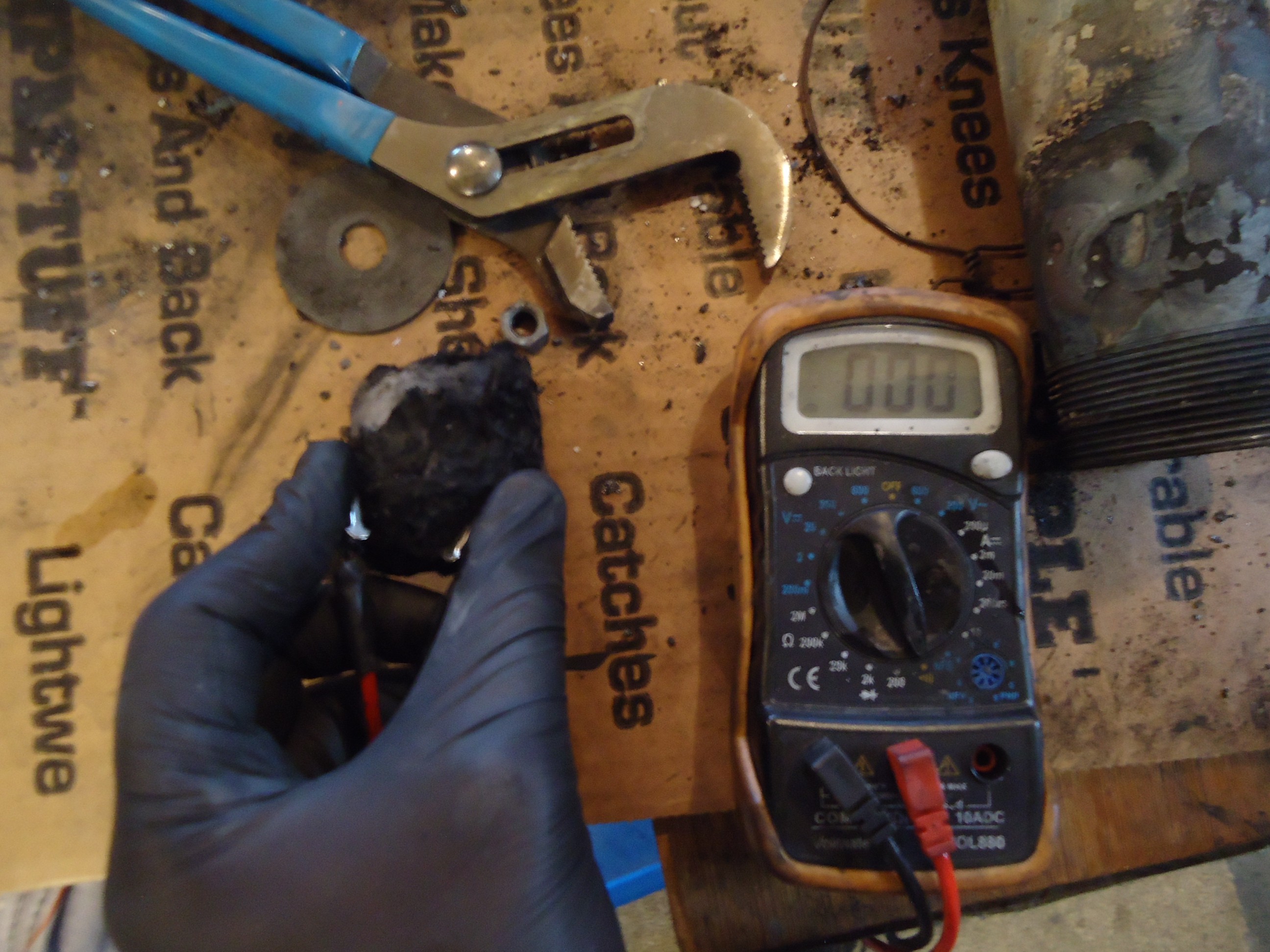-
Finally no resistance in the monolith
07/11/2016 at 01:27 • 0 commentsI put the ammonia soaked cotton in a pipe, and beat the heck out of it to fully compress it with a hammer and chisel.
Then pyrolitically graphitized it at 900 degrees celcius in my forge. As you can see the resistance reading is zero.
Next step is to activate it, so I dunked it in 6M KOH. and back in the forge for 60 minutes.
-
After about 1.5 years fleshing this thing out I think I have it made.
06/24/2016 at 07:11 • 0 commentsI have tried practically every last method known to make a high performance supercapacitor I can use in my power armor, prosthesis, and space planes.
I think I finally figure it out and it should have been obvious but it wasn't. Batteries must have very thin active materials very close to each other because of how they work. Ions such as lithium has to travel all the way from the anode to the cathode when discharging, so rate capability (c discharge rating and charge rating) is impacted by distance. However supercapacitors operate completely differently. The charge is stored directly on the active material and faradaic redox reactions at the cathode only occur at the cathode, meaning no ions have to migrate all the way through an electrolyte.
This means as long as the active materials for each electrode are conductive enough to not cause ohmic losses through resistance they can be incredibly thick. Illustration below
![]()
I finally got the materials in today to remake my forge, it's a little too hot at the moment to run the fireplace so I can proceed. -
The Good, The Bad, and the Incredibly Poor
06/24/2016 at 05:56 • 0 commentsA repository for the old supercapacitors I had to slog through to get to this point.
-
With Electrolysis I Can Push 1.5 Amps Per Gram Instantaneous
03/30/2016 at 11:24 • 0 comments -
THE POWER .625 Amps 2.2 volts per gram!
03/30/2016 at 10:38 • 0 commentsAqueous Super-capacitors are the ticket, if you want power now!
-
Oxidized Carbons for Storing Electrolyzed Hydrogen
03/26/2016 at 00:31 • 0 commentsThe main problem with aqueous electrolytes especially basic or acidic ones is that they are limited to around .8 volts full cell potential due to electrolysis of the water and evolution of oxygen at the cathode and hydrogen at the anode.
Yes your multimeter may read 1.2 volts potential open circuit but the cell will quickly self discharge to .8volts in a few minutes.
In order to fix this pH neutral electrolytes need to be used and an oxygen scavenger must be present. Cathodic corrosion inhibitors such as potassium nitrite or sodium molybdate are great candidates.
For the anode, oxygen groups present on the carbons can easily store the hydrogen evolved from electrolysis in faradaic redox reactions.
At the cathode when we have KI present iodate- or I2- forms and can be reduced. This produces even more faradaic redox reactions.
These reactions happening at both the anode and cathode defy conventional wisdom on how psuedocapacitors work and things start to look like a battery.
At this point the discharge curves no longer act like capacitors and we can no longer consider them as such. Consequently we also approach energy storage densities of lithium ion batteries. Expressed in farads it would be around 600 farads per gram of active material but as I said that is not an intelligent way to describe these systems. It is best to being using watt hours per gram this also gives us a great comparison between lithium ion and our ultra-capacitors.
-
How many Poles does it take to make a breakthrough?
03/22/2016 at 12:51 • 0 commentsTurns out only 3!
Water Based AC/AC Supercapacitors Reaching the Performance of Systems in Organic Electrolyte
http://ma.ecsdl.org/content/MA2014-02/3/211.abstract
I will be combining this method with my nitrogen plasma functionalized AC and hopefully get 500 farads per gram at 1.6 volts! Or use oxidized AC and get 1.9 volts potential.
Very excited!
-
What I tried tonight
03/22/2016 at 12:00 • 0 commentsGraphene, SiO2(DE crystalline), CuCl2, Carbon Black Cathode/ N-AC anode/ K2SO4 aqueous electrolyte
-Result horrible performance .6 volts and rapid leakage
CuCl2 Graphene Cathode/ N-AC anode/ DMSO KOH PVA electrolyte
-Poor Performance not better than aqueous electrolyte
CuCl2 Cathode/ N-AC anode/ .5 Molar K2SO4 aqueous electrolyte
-Ok results .6 volts around 200 farads per gram
Symmetric EDLC capacitor with N-AC for both electrodes/ K2SO4 aqueous electrolyte
-Superb results very fast cycling and charging typical 50 farads per gram EDLC performance 1.9 volts potential rivaling exotic organic electrolytes.
-Needs Carbon Black for increased conductivity of electrodes, as discharge was a little slow
N-AC in polyurethane painted very well
Tried 6 N-AC electrodes in parallel and had 150mA leakage current best guess is unbalanced electrodes, but painting by hand this is to be expected.
Moving forward Li2SO4 comes on thursday and is much more soluble in water, will retry EDLC with 2 molar solution instead of .5 molar K2SO4
Improvements to be made to CuCl2 ultracapacitor are adsorbing the transition metal chloride into activated carbon to increase conductivity of the colloid. Most likely requires KOH or LiOH to function properly, results were poor with K2SO4.
I started ball milling some DE amorphous with MnO2 as the SiO2 should increase the psuedocapacitive effect on the cathode.
Need to retest CuCl2 SiO2 with KOH electrolyte.
Need to nitrogen plasma functionalize MWCNT and try with K2SO4.
Need to oxidize AC with H2O2 35% and test vs Microwave nitrogen plasma functionalized, as well as ammonia functionalized ox-AC.
Need to test potassium iodide as redox mediator in transition metal oxide, ie MnO2 SiO2 cathode. .1 molar concentration in K2SO4.
-
Myriad Methods
12/17/2015 at 06:46 • 0 commentsMoving into all aqueous neutral electrolytes should provide the highest voltages and energy densities in these materials at the lowest cost possible.
I am moving into using potassium sulfate and lithium sulfate as the electrolyte and 1.9 volts is stable as opposed to my best 1.2/1.3 volts achieved previously.
2 molar concentrations will be used.
Monolithic Cotton Supercapacitors
HAL 9000: I am putting myself to the fullest possible use, which is all I think that any conscious entity can ever hope to do.
 MECHANICUS
MECHANICUS

